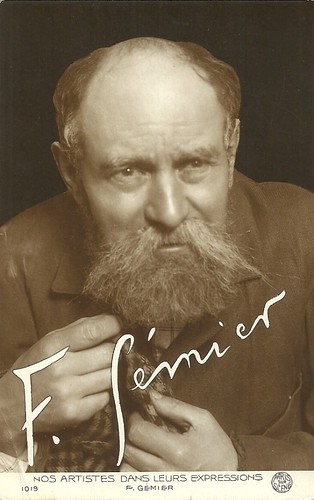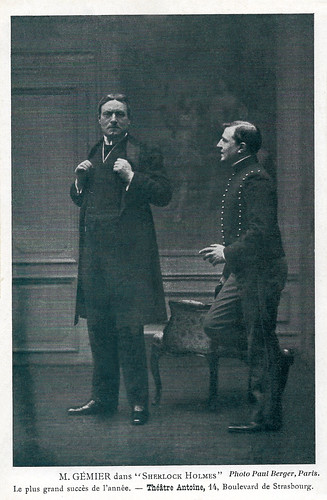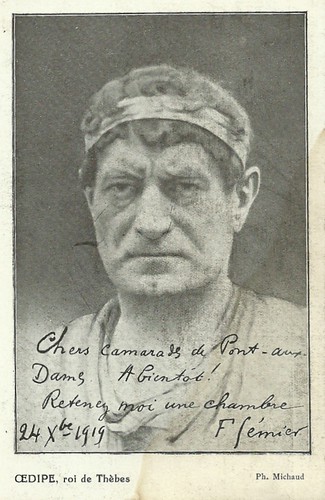Firmin Gémier (1869-1933) was an actor, director, and theatre manager at the French stage. He was a promoter of theatre for the people and founder of the first Théâtre National Populaire in Paris in 1920. From the 1910s to the 1930s, Gémier also acted in silent and sound French films.

French postcard by Imprimerie Darjeanne. Photo: Paul Gerber, Paris. Firmin Gémier in the play 'Sherlock Holmes', at the Théâtre Antoine, Paris. The play (1899) by William Gillette based on the famous stories by Arthur Conan Doyle, was first performed in a French version by Pierre Decourcelle, at the Théâtre Antoine in Paris in 1907.

French postcard by Imprimerie Darjeanne. Photo: Paul Berger, Paris. Firmin Gemier in the play 'Sherlock Holmes', at the Théâtre Antoine, Paris.

French postcard in the Nos artistes dans leur loges series, no. 118. Photo: Comoedia.

French postcard in the Nos artistes dans leurs expressions series, no. 1019, by Paris sur scene.
Firmin Gémier was born as Firmin Tonnerre in Aubervilliers, France, in 1869. His father was a tanner, and his mother came from a family of carpenters.
Living in the Parisian worker's quarter of Belleville, he was able to go to the upper primary school Turgot thanks to a scholarship. Twice refused to study at the Conservatory, he studied acting in neighbourhood theatres, including the Théâtre de Belleville and that of Bouffes du Nord.
In 1892 (some sources say 1891), he entered the famous Théâtre Libre of André Antoine, where he worked as an actor and as a stage manager. While working for Antoine, Firmin Gémier discovered his desire to offer quality theatre at a cheap price. His debut role was that of Ubu in the first performance of Ubu Roi by Alfred Jarry, at the Nouveau-Théâtre.
He then left Antoine with some other members of the troupe and played at the Théâtre du Gymnase for one season. Then he directed the Théâtre de la Renaissance, where he tried out the popular theatre for the first time with the staging of 'Quatorze Juillet' by Romain Rolland in 1902. Many plays at the Renaissance followed that year. To pay for the contractual debts at the Renaissance, he became an actor in 1903.
He associated with Camille de Sainte-Croix to create a popular Parisian theatre, which was backed by the committee of the Chambre des Députés (House of Commons) in 1906 but refused by the Paris City Council. At the Odéon, he also staged La Rabouilleuse after Honoré de Balzac, in which he played Philippe Bridau.

French postcard. Firmin Gémier as Colonel Philippe Bridau in 'La Rabouilleuse', at the Théâtre Antoine, Paris. After a portrait by Louis Anquetin. Gémier originally played the part in 1903 at the Odéon and it was then that Anquetin painted his portrait. 'La Rabouilleuse' was a play by Emile Fabre after a novel by Honoré de Balzac. Apparently, the play was reprised at the Théâtre Antoine, which Gémier ran between 1906 and 1919.

French postcard by Imprimerie Darjeanne. Photo: Paul Berger, Paris. Firmin Gémier in the play 'Sherlock Holmes' at the Théâtre Antoine, Paris. Caption: The biggest success of the year.

French postcard by Imprimerie Darjeanne, Paris. Photo: Paul Berger. Firmin Gémier in the play 'Sherlock Holmes', at the Théâtre Antoine in Paris.
Between 1906 and 1919, Firmin Gémier was the head of the Théâtre Antoine. He alternated popular hits with new authors to balance the revenues. Influenced by Romain Rolland and his ‘théâtre pour le peuple’ (theatre for the people) and by the Théâtre du Peuple at Bussang, Gémier created the Théâtre National Ambulant (1911-1912), with the help of Joseph Paul-Boncour.
The Théâtre National Ambulant was a removable auditorium with seating for 1650 persons. With several trucks for the transport of the auditorium, he travelled across France to present the pieces he had staged with the Théâtre Antoine in Paris, such as Anna Karenina, La Rabouilleuse and Les Gaîtés de l'escadron. Despite its big popular success, the revenues of the Théâtre National Ambulant were insufficient, and the experience was quickly abandoned.
In 1917 Gémier founded the Société Shakespeare and created The Merchant of Venice. Like Antoine, Gémier sought to renew the mise-en-scène: he made the auditorium part of the stage, used the effects of crowds, continued Antoine’s work on lightning by removing the ramp, and worked with Émile Jaques-Dalcroze to integrate music in the representation.
In 1920, Gémier founded the Théâtre National Populaire in Paris at the Palais de Chaillot. According to critic Régis Messac, Firmin Gémier found ‘the exact formula of the Popular Theatre. [...] Gémier has thought of offering the people sights that are beautiful, emotional, artistic - and aristocratic. He presents old and new masterpieces of our drama, with the best actors. [...] Excellent orchestras play Beethoven or Mozart. [...] The people press to these magnificent performances. People with taste expressed to be enchanted and delighted. "
Gémier also simultaneously ran one of France's national theatres, the Théâtre de l'Odéon (1921-1929, some sources say 1922-1930). In 1924, he organised the ceremonial transfer of the remains of French Socialist leader Jean Jaures to the Panthéon, the secular mausoleum in Paris containing the remains of distinguished French citizens.

French postcard by F.C. & Cie, no. 46-2. Photo: Henri Manuel.

French postcard by FA, no. 94. Photo: Henri Manuel. Caption: Firmin Gémier, Comédie Française.

French postcard. Photo: Michaud. Publicity still of Firmin Gémier in the stage production Oedipe, roi de Thèbes. Written: "Chers camarades de Pont-aux-Dame. A' bientôt! Retenez-moi une chambre. 24 Octobre 1919. F. Gémier." (Dear fellows of Pont-aux-Dame. See you soon! Keep a room for me.)
Incidentally, Firmin Gémier was also a film actor and director. His cinema debut was for Pathé Frères in L'Homme qui assassina/The man who murdered (Henri Andréani, 1913). Earlier he had directed a short film for Pathé, Le père Milon/Father Milon (Firmin Gémier, Henry Houry, 1909), an adaptation of a story by Guy de Maupassant about the Franco-Prussian War. In 1917 he played Emile Berliac, one of the leads in Abel Gance’s Mater Dolorosa/Sorrowful Mother/The Torture of Silence, opposite Emmy Lynn as Manon Berliac and Armand Tallier as François Rolland.
In the 1920s he acted in La Branche morte/The Dead Branch (Giuseppe Guarino, 1926) with Dolly Davis, and played Dr. Porhoet in Rex Ingram’s The Magician (1926), an MGM production shot in Paris and Nice and based on a novel by Somerset Maugham. The Magician starred Alice Terry as a female sculptor who has an affair with a surgeon (Iván Petrovich) who saves her. However, another doctor and hypnotist (Paul Wegener) is doing experiments for which he needs female blood…
In the 1930s, Gémier acted in a few sound films. First, he was Heinrich Martin in Un homme sans nom/A man without a name (Roger Le Bon, Gustav Ucicky, 1932), based on Balzac’s Le Colonel Chabert. Gémier had the lead as a German industrial who 15 years after the war returns to Germany but cannot cope with his identity as he is officially declared dead. He changes his name, leaves his wife to his assistant who also has taken over the direction of the firm, and starts a new life. A simultaneously made German version of the film, Mensch ohne Nahmen, had Werner Krauss in the lead.
Gémier also had the lead in the only film he directed himself, Le Simoun (Firmin Gémier, 1933). Originally Rex Ingram would have filmed Le Simoun, with exteriors in North Africa and interiors in his studio in Nice. After the flop of Ingram's film Baroud, his loss of control at the Nice studio, and his old crew leaving him alone, Rex Ingram quit the project and filmmaking. Le Simoun was released four weeks after Gémier’s death. It was not a financial success. Then Gémier had his last film part in La Fusée/Grandeur and Decadence (Jacques Natanson, 1933). Gémier played Etienne Girbal, a factory owner who loses his wife (Marcelle Géniat) and is ruined because of the crisis, so he has to start all over again.
In 2004, Nathalie Coutelet stated in the French film historical journal 1895: "Gémier exemplifies the transition made by most theatre artists to cinema at the beginning of the 20th century. He participated in silent films, then talkies… taking up certain of his former roles with success. An emblematic figure in adapting theatre acting to the cinema, he turned to his usual creative techniques: sincerity, emotion, interiority, and naturalness. The close relationship between the cinema and theatre was evident for Gémier. Yet, he conceived of cinematographic interpretation as a potential means for modernising acting and actor training, as well as a means for artistic polyvalence and international collaboration." Firmin Gémier died of heart failure in 1933 in Paris. An ardent admirer of Shakespeare, at the time of his death he was in the process of adapting The Merchant of Venice to the cinema. As an homage, the Théâtre Firmin Gémier was founded in 1967 in Ville d'Antony in the region Île-de-France.

French postcard by P, no. 94.

French postcard by Editions Cinémagazine, no. 343.

French postcard in the Collection Théâtrale du P. P. P. Firmin Gémier in the play 'Sherlock Holmes' at the Théâtre Antoine, Paris. Caption: 4th Act - Moriarty - At no cost, I do not want this lamp! ....
Sources: Nathalie Coutelet (1895 - French), Leonhard Gmür (Rex Ingram: Hollywood's Rebel of the Silver Screen), Wikipedia (French), and IMDb.
This post was last updated on 11 May 2024.

French postcard by Imprimerie Darjeanne. Photo: Paul Gerber, Paris. Firmin Gémier in the play 'Sherlock Holmes', at the Théâtre Antoine, Paris. The play (1899) by William Gillette based on the famous stories by Arthur Conan Doyle, was first performed in a French version by Pierre Decourcelle, at the Théâtre Antoine in Paris in 1907.

French postcard by Imprimerie Darjeanne. Photo: Paul Berger, Paris. Firmin Gemier in the play 'Sherlock Holmes', at the Théâtre Antoine, Paris.

French postcard in the Nos artistes dans leur loges series, no. 118. Photo: Comoedia.

French postcard in the Nos artistes dans leurs expressions series, no. 1019, by Paris sur scene.
Refused at the Conservatory
Firmin Gémier was born as Firmin Tonnerre in Aubervilliers, France, in 1869. His father was a tanner, and his mother came from a family of carpenters.
Living in the Parisian worker's quarter of Belleville, he was able to go to the upper primary school Turgot thanks to a scholarship. Twice refused to study at the Conservatory, he studied acting in neighbourhood theatres, including the Théâtre de Belleville and that of Bouffes du Nord.
In 1892 (some sources say 1891), he entered the famous Théâtre Libre of André Antoine, where he worked as an actor and as a stage manager. While working for Antoine, Firmin Gémier discovered his desire to offer quality theatre at a cheap price. His debut role was that of Ubu in the first performance of Ubu Roi by Alfred Jarry, at the Nouveau-Théâtre.
He then left Antoine with some other members of the troupe and played at the Théâtre du Gymnase for one season. Then he directed the Théâtre de la Renaissance, where he tried out the popular theatre for the first time with the staging of 'Quatorze Juillet' by Romain Rolland in 1902. Many plays at the Renaissance followed that year. To pay for the contractual debts at the Renaissance, he became an actor in 1903.
He associated with Camille de Sainte-Croix to create a popular Parisian theatre, which was backed by the committee of the Chambre des Députés (House of Commons) in 1906 but refused by the Paris City Council. At the Odéon, he also staged La Rabouilleuse after Honoré de Balzac, in which he played Philippe Bridau.

French postcard. Firmin Gémier as Colonel Philippe Bridau in 'La Rabouilleuse', at the Théâtre Antoine, Paris. After a portrait by Louis Anquetin. Gémier originally played the part in 1903 at the Odéon and it was then that Anquetin painted his portrait. 'La Rabouilleuse' was a play by Emile Fabre after a novel by Honoré de Balzac. Apparently, the play was reprised at the Théâtre Antoine, which Gémier ran between 1906 and 1919.

French postcard by Imprimerie Darjeanne. Photo: Paul Berger, Paris. Firmin Gémier in the play 'Sherlock Holmes' at the Théâtre Antoine, Paris. Caption: The biggest success of the year.

French postcard by Imprimerie Darjeanne, Paris. Photo: Paul Berger. Firmin Gémier in the play 'Sherlock Holmes', at the Théâtre Antoine in Paris.
Beautiful, emotional, artistic - and aristocratic - sights
Between 1906 and 1919, Firmin Gémier was the head of the Théâtre Antoine. He alternated popular hits with new authors to balance the revenues. Influenced by Romain Rolland and his ‘théâtre pour le peuple’ (theatre for the people) and by the Théâtre du Peuple at Bussang, Gémier created the Théâtre National Ambulant (1911-1912), with the help of Joseph Paul-Boncour.
The Théâtre National Ambulant was a removable auditorium with seating for 1650 persons. With several trucks for the transport of the auditorium, he travelled across France to present the pieces he had staged with the Théâtre Antoine in Paris, such as Anna Karenina, La Rabouilleuse and Les Gaîtés de l'escadron. Despite its big popular success, the revenues of the Théâtre National Ambulant were insufficient, and the experience was quickly abandoned.
In 1917 Gémier founded the Société Shakespeare and created The Merchant of Venice. Like Antoine, Gémier sought to renew the mise-en-scène: he made the auditorium part of the stage, used the effects of crowds, continued Antoine’s work on lightning by removing the ramp, and worked with Émile Jaques-Dalcroze to integrate music in the representation.
In 1920, Gémier founded the Théâtre National Populaire in Paris at the Palais de Chaillot. According to critic Régis Messac, Firmin Gémier found ‘the exact formula of the Popular Theatre. [...] Gémier has thought of offering the people sights that are beautiful, emotional, artistic - and aristocratic. He presents old and new masterpieces of our drama, with the best actors. [...] Excellent orchestras play Beethoven or Mozart. [...] The people press to these magnificent performances. People with taste expressed to be enchanted and delighted. "
Gémier also simultaneously ran one of France's national theatres, the Théâtre de l'Odéon (1921-1929, some sources say 1922-1930). In 1924, he organised the ceremonial transfer of the remains of French Socialist leader Jean Jaures to the Panthéon, the secular mausoleum in Paris containing the remains of distinguished French citizens.

French postcard by F.C. & Cie, no. 46-2. Photo: Henri Manuel.

French postcard by FA, no. 94. Photo: Henri Manuel. Caption: Firmin Gémier, Comédie Française.

French postcard. Photo: Michaud. Publicity still of Firmin Gémier in the stage production Oedipe, roi de Thèbes. Written: "Chers camarades de Pont-aux-Dame. A' bientôt! Retenez-moi une chambre. 24 Octobre 1919. F. Gémier." (Dear fellows of Pont-aux-Dame. See you soon! Keep a room for me.)
Sincerity, emotion, interiority, naturalness
Incidentally, Firmin Gémier was also a film actor and director. His cinema debut was for Pathé Frères in L'Homme qui assassina/The man who murdered (Henri Andréani, 1913). Earlier he had directed a short film for Pathé, Le père Milon/Father Milon (Firmin Gémier, Henry Houry, 1909), an adaptation of a story by Guy de Maupassant about the Franco-Prussian War. In 1917 he played Emile Berliac, one of the leads in Abel Gance’s Mater Dolorosa/Sorrowful Mother/The Torture of Silence, opposite Emmy Lynn as Manon Berliac and Armand Tallier as François Rolland.
In the 1920s he acted in La Branche morte/The Dead Branch (Giuseppe Guarino, 1926) with Dolly Davis, and played Dr. Porhoet in Rex Ingram’s The Magician (1926), an MGM production shot in Paris and Nice and based on a novel by Somerset Maugham. The Magician starred Alice Terry as a female sculptor who has an affair with a surgeon (Iván Petrovich) who saves her. However, another doctor and hypnotist (Paul Wegener) is doing experiments for which he needs female blood…
In the 1930s, Gémier acted in a few sound films. First, he was Heinrich Martin in Un homme sans nom/A man without a name (Roger Le Bon, Gustav Ucicky, 1932), based on Balzac’s Le Colonel Chabert. Gémier had the lead as a German industrial who 15 years after the war returns to Germany but cannot cope with his identity as he is officially declared dead. He changes his name, leaves his wife to his assistant who also has taken over the direction of the firm, and starts a new life. A simultaneously made German version of the film, Mensch ohne Nahmen, had Werner Krauss in the lead.
Gémier also had the lead in the only film he directed himself, Le Simoun (Firmin Gémier, 1933). Originally Rex Ingram would have filmed Le Simoun, with exteriors in North Africa and interiors in his studio in Nice. After the flop of Ingram's film Baroud, his loss of control at the Nice studio, and his old crew leaving him alone, Rex Ingram quit the project and filmmaking. Le Simoun was released four weeks after Gémier’s death. It was not a financial success. Then Gémier had his last film part in La Fusée/Grandeur and Decadence (Jacques Natanson, 1933). Gémier played Etienne Girbal, a factory owner who loses his wife (Marcelle Géniat) and is ruined because of the crisis, so he has to start all over again.
In 2004, Nathalie Coutelet stated in the French film historical journal 1895: "Gémier exemplifies the transition made by most theatre artists to cinema at the beginning of the 20th century. He participated in silent films, then talkies… taking up certain of his former roles with success. An emblematic figure in adapting theatre acting to the cinema, he turned to his usual creative techniques: sincerity, emotion, interiority, and naturalness. The close relationship between the cinema and theatre was evident for Gémier. Yet, he conceived of cinematographic interpretation as a potential means for modernising acting and actor training, as well as a means for artistic polyvalence and international collaboration." Firmin Gémier died of heart failure in 1933 in Paris. An ardent admirer of Shakespeare, at the time of his death he was in the process of adapting The Merchant of Venice to the cinema. As an homage, the Théâtre Firmin Gémier was founded in 1967 in Ville d'Antony in the region Île-de-France.

French postcard by P, no. 94.

French postcard by Editions Cinémagazine, no. 343.

French postcard in the Collection Théâtrale du P. P. P. Firmin Gémier in the play 'Sherlock Holmes' at the Théâtre Antoine, Paris. Caption: 4th Act - Moriarty - At no cost, I do not want this lamp! ....
Sources: Nathalie Coutelet (1895 - French), Leonhard Gmür (Rex Ingram: Hollywood's Rebel of the Silver Screen), Wikipedia (French), and IMDb.
This post was last updated on 11 May 2024.
No comments:
Post a Comment